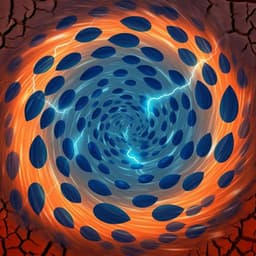
Earth Sciences
Eddy activity in the Arctic Ocean projected to surge in a warming world
X. Li, Q. Wang, et al.
This study, conducted by Xinyue Li, Qiang Wang, Sergey Danilov, Nikolay Koldunov, Caili Liu, Vasco Müller, Dmitry Sidorenko, and Thomas Jung, reveals a dramatic tripling in eddy kinetic energy in the Arctic Ocean due to climate warming. With a focus on the vital role of Arctic eddy activity, this research emphasizes the importance of accurate climate models to understand the impacts on climate and ecosystems.
~3 min • Beginner • English
Introduction
The study investigates how Arctic Ocean mesoscale eddy activity will respond to strong anthropogenic warming, a key uncertainty because conventional climate models cannot resolve the Arctic’s small eddies (~10 km or smaller). Given rapid Arctic amplification, sea-ice loss, and ocean warming, the authors hypothesize that eddy kinetic energy (EKE) in the upper Arctic Ocean will markedly intensify, primarily due to enhanced baroclinic instability and associated eddy generation, while the annual-mean damping by sea ice and winds (eddy killing) may not decline despite reduced sea-ice cover. The work aims to quantify the magnitude, spatial patterns, mechanisms (generation vs killing), and seasonal modulation of future Arctic eddy activity using kilometre-scale ocean–sea-ice simulations.
Literature Review
Mesoscale eddies, the ocean’s weather, are central to transports of heat, salt, carbon, oxygen, and nutrients, impacting climate and ecosystems (refs. 2–8). Satellite altimetry shows rising eddy activity (2–5% per decade) in many eddy-rich regions since 1993 (ref. 9), and models project continued intensification under warming, except in the North Atlantic (ref. 10). In the Arctic, knowledge is limited because typical CMIP6 ocean resolutions (30–50 km) cannot resolve ~10 km eddies, and observations are sparse due to remoteness and sea ice. Observations nonetheless indicate Arctic eddies shape halocline properties and shelf–basin exchanges (refs. 17–19), influence freshwater storage and circulation in the Beaufort Gyre (refs. 20–25), and are damped by sea ice via friction (refs. 26–29). Sea-ice decline could enhance eddy growth (refs. 26–29). Conflicting assessments exist for recent changes in western Arctic eddy activity: increases inferred from energy budgets (ref. 28) versus relatively small increases tied to gyre expansion (ref. 30). Concurrent Arctic atmospheric warming, sea-ice loss, and ocean changes (refs. 31–39) motivate assessing future eddy responses.
Methodology
Model: Finite-Volume Sea Ice–Ocean Model version 2 (FESOM2) on unstructured grids enabling variable resolution. Two configurations: (1) Eddy-rich Arctic: 1 km horizontal resolution in the Arctic and 30 km elsewhere; 70 vertical layers (5 m resolution in upper 100 m). (2) Eddy-present Arctic: 4.5 km in the Arctic; 48 vertical layers. Simulation design: Eddy-present run from 1958–2100 initialized from PHC3.0 climatology. Eddy-rich three time-slice runs, each 6 model years, initialized from the eddy-present state at end of 2009, 2049, 2089: periods 2010–2015, 2050–2055, 2090–2095; first 2 years for re-spin-up, last 4 years analyzed (2012–2015, 2052–2055, 2092–2095). Forcing: Atmospheric fields and river runoff from AWI-CM CMIP6 historical (to 2014) and SSP585 (2015–2100) simulation; ~T127 spatial resolution (~100 km meridional; ~27 km at 75° N zonal), 3-hourly temporal resolution. The SSP585 forcing yields ~+4 K global mean surface air temperature in the 2090s relative to 2000–2015, consistent with CMIP6 multi-model means. Sea-ice extent evolution matches observations and reaches ice-free September conditions in the 2050s. Drag coefficients: Constant ice–ocean and ice–air drag as in AWI-CM. Diagnostics: - EKE calculation via Reynolds averaging with seasonal (3-month) means for the mean flow; also via spatial coarse-graining to isolate kinetic energy on scales smaller than 50 km, chosen from energy spectra peaks after removing coarse (>100 km) energy. Surface normalized EKE computed relative to historical mean and variability. - Energy spectrum of surface currents computed using spatial filtering/coarse-graining to obtain scale-dependent kinetic energy density; eddy scale identified at ~50 km. - Eddy killing (eddy power) diagnosed using spatial coarse-graining EP^C = (τ·u) − (τ)(u), where (...) denotes low-pass filtering at scale l; negative values indicate removal of kinetic energy from eddies. EP^C computed from daily total surface stress (winds + sea ice) and currents; contributions cannot be reliably separated grid-cell-wise but seasonal analysis isolates sea-ice-dominated months (Feb–May) and ice-free months (Aug–Nov). - Eddy generation diagnosed as conversion from eddy available potential energy to EKE using τ_BC = −g w′ρ′ (Reynolds averaging). - Trend estimation: Linear trends of top-200 m mean EKE for the 12 analyzed years (three time slices) with two-sided t-test for significance. Additional diagnostics: EKE in depth layers (0–100 m, 100–200 m), within the mixed layer, and above halocline base; TKE and MKE maps; seasonal cycles of EKE, sea-ice area, and baroclinicity; regional analyses (Arctic Ocean, Canada Basin, Eurasian Basin).
Key Findings
• Arctic upper-ocean EKE strongly increases under warming. In eddy-rich (1 km) simulations, mean EKE in the upper 200 m exhibits a significant trend of (1.39 ± 0.07) × 10^3 m^2 s^−2 per decade (P < 0.01) across 2012–2015, 2052–2055, 2092–2095; eddy-present (4.5 km) trend is about half, (0.70 ± 0.03) × 10^3 m^2 s^−2 per decade (P < 0.01). By 2092–2095, upper-200 m EKE is ~3× 2012–2015 in the Arctic Ocean and Canada Basin and ~4× in the Eurasian Basin. • Surface EKE normalization surges: normalized surface EKE reaches ~15 times the historical variability (σ) by century’s end in both resolutions. • Vertical structure: EKE increases in both 0–100 m and 100–200 m, with larger increases near the surface; EKE rises in both the surface mixed layer and above the halocline base. • Spatial patterns: Present-day high-EKE regions (Fram Strait, along the Eurasian slope, Lomonosov Ridge, southern Beaufort and Barents seas) experience the largest future EKE increases. • Mechanism—enhanced eddy generation: The conversion from eddy available potential energy to EKE (τ_BC) increases markedly, especially in the upper ocean, linked to (i) steeper isopycnal slopes due to upper-ocean freshening (sea-ice meltwater, precipitation, river runoff) and (ii) reduced sea-ice friction facilitating eddy growth. In the Canada Basin, τ_BC increases with rising available potential energy from Beaufort Gyre freshwater accumulation. • Eddy killing response: Winter–spring (Feb–May) eddy killing strengthens despite somewhat lower sea-ice concentration, with mean EKE removal of 0.17 mW m^−2 in 2092–2095—about 40% higher than 2012–2015—reflecting stronger eddy activity. In late summer–fall (Aug–Nov), eddy killing weakens by ~27% as sea ice vanishes and winds dominate eddy damping. Regionally, annual-mean eddy killing increases where EKE rises (Canada Basin, eastern Eurasian Basin) and shows weak spatial correlation with wind speed changes. • Generation vs killing regime shift: Arctic-wide in 2012–2015, τ_BC ≈ 0.10 mW m^−2 and surface eddy power ≈ −0.09 mW m^−2, indicating sea-ice-controlled eddy activity. In 2092–2095, τ_BC ≈ 0.26 mW m^−2 and surface eddy power ≈ −0.11 mW m^−2; τ_BC increases by ~2.6× while annual-mean eddy killing increases by ~20%, showing that enhanced eddy generation, not reduced killing, drives the surge in EKE. • Seasonality: The seasonal cycle of surface EKE remains highly anti-correlated with sea-ice area (r ≈ −0.9 for Arctic/Eurasian basins), not with τ_BC, demonstrating persistent direct surface suppression by sea ice during ice-covered months, despite increased subsurface eddy activity. • Energy spectrum and scales: Surface current spectra show a kinetic energy peak near 50 km (after removing >100 km scales) in both present and future climates, used as the upper bound for eddy scales in EP^C diagnostics. • Additional: TKE and MKE both increase; the Arctic gains more large-scale kinetic energy input in 2092–2095, especially during ice-free seasons. The study estimates that lacking atmospheric coupling likely underestimates the EKE increase; the true EKE increase might be ~3.5× instead of ~3×.
Discussion
The results strongly support the hypothesis that Arctic mesoscale eddy activity will intensify dramatically under strong warming, with upper-200 m EKE projected to triple by the late 21st century. Mechanistic analyses demonstrate that increased eddy generation, via enhanced baroclinic instability from greater available potential energy and reduced sea-ice friction, dominates over changes in eddy killing. Although sea-ice loss reduces eddy damping in summer–fall, eddy killing strengthens during the ice-covered months due to intensified eddy activity, leaving the annual-mean killing effect comparable in magnitude. This implies a regime shift from a sea-ice-controlled to a generation-dominated eddy field reminiscent of midlatitudes where winds govern eddy damping. The pronounced increase in surface EKE relative to historical variability (~15σ) signifies a transformative change in Arctic variability, with potential consequences for heat, carbon, oxygen, and nutrient transports, shelf–basin exchanges, freshwater storage (e.g., Beaufort Gyre), and air–sea fluxes. Seasonally, surface EKE will remain strongly constrained by sea-ice coverage, even as subsurface eddies intensify, affecting vertical mixing and halocline structure. These changes underscore the need to represent Arctic eddies adequately in climate models to capture feedbacks on regional and global climate and ecosystems.
Conclusion
Using kilometre-scale Arctic ocean–sea-ice simulations, the study projects that upper-200 m EKE will roughly triple in a +4 K world, with the largest increases in regions already eddy-active today. The dominant driver is enhanced eddy generation from increased baroclinicity and reduced sea-ice friction, while annual-mean eddy killing remains of similar magnitude but with strengthened winter–spring damping and weakened summer–fall damping. Surface EKE is projected to increase by ~15 times historical variability, indicating a step change in Arctic dynamical activity. These changes imply stronger eddy-mediated transports and altered air–sea interactions, potentially reshaping Arctic climate and ecosystems. Future work should: (1) include fully coupled atmosphere–ice–ocean simulations to capture feedbacks and refine eddy killing by winds; (2) implement variable, state-dependent ice–ocean and ice–air drag parameterizations (including evolving sea-ice roughness) to reduce uncertainty; (3) extend eddy-rich simulations beyond short time slices with longer spin-up; (4) increase resolution on shelves to better resolve submesoscale and shelf-sea eddies; and (5) improve diagnostics closing the EKE budget consistently across spatial and temporal scales.
Limitations
Key uncertainties include: (i) lack of dynamic atmosphere–ocean coupling in forced simulations, which can overestimate eddy killing by winds and likely underestimates future EKE increases (authors estimate true EKE increase could be ~3.5× vs simulated ~3×); (ii) use of constant ice–ocean and ice–air drag coefficients despite uncertain future sea-ice roughness and drag changes, potentially underestimating eddy growth with thinning ice; (iii) short eddy-rich time slices with only ~2-year re-spin-ups and initialization from eddy-present states; (iv) 1 km resolution insufficient to resolve mesoscale in shallow shelf seas where Rossby radius is smaller; (v) inability to separate sea-ice vs wind contributions to EP^C on grid cells; (vi) comparing τ_BC (temporal averaging) with EP^C (spatial averaging) does not close the EKE budget; (vii) choice of 50 km threshold for EKE via coarse-graining may omit larger eddies and include some mean-current energy if thresholds vary.
Related Publications
Explore these studies to deepen your understanding of the subject.







